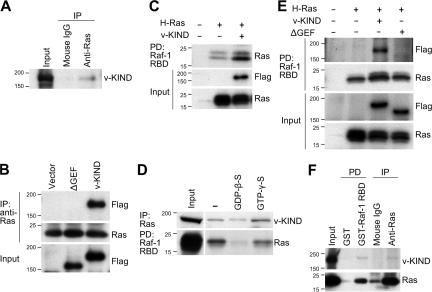Figure 2.
v-KIND protein acts as a Ras GEF in mouse cerebellum. (A) Coimmunoprecipitation of Ras with v-KIND from mouse cerebellar lysates. Equal amounts of cerebellar lysates from P21 mice were immunoprecipitated with the anti-Ras antibody and immunoblotted with the anti-v-KIND antibody. (B) RasGEF domain was responsible for v-KIND-Ras association. Equal amounts of protein lysates from COS7 cells expressing FLAG-tagged v-KIND or a v-KIND mutant lacking the RasGEF domain (ΔGEF) were immunoprecipitated with the anti-Ras antibody and immunoblotted with the anti-FLAG antibody (top panel). Middle panel, Ras in the immunoprecipitates. Bottom panel, FLAG-tagged v-KIND and ΔGEF in whole lysates. (C) v-KIND activated H-Ras. Activated H-Ras (GTP-Ras) in cells with or without FLAG-tagged v-KIND coexpression was analyzed by pull-down assay using GST-Raf-1- RBD. The protein complex was then subjected to immunoblotting with anti-Ras and anti-FLAG antibody. (D) Binding of v-KIND to Ras-GDP and Ras-GTP. Equal amounts of mouse hippocampal protein lysate were treated by GDP-β-S or GTP-γ-S, and then investigatedby Raf-1 RBD pull-down assay. Top panel, v-KIND binding with Ras in the presence of GDP-β-S or GTP-γ-S; Bottom panel, the quantity of GTP-Ras. (E) GST-Raf-1-RBD pulled down activated GTP-Ras (second panel) together with FLAG-tagged v-KIND, but not ΔGEF (top panel). (F) v-KIND protein was pulled down with GTP-Ras by GST-Raf-1-RBD from mouse cerebellum. Top panel, v-KIND in the pull-down lysate; bottom panel, activated Ras in the pull-down lysate.

